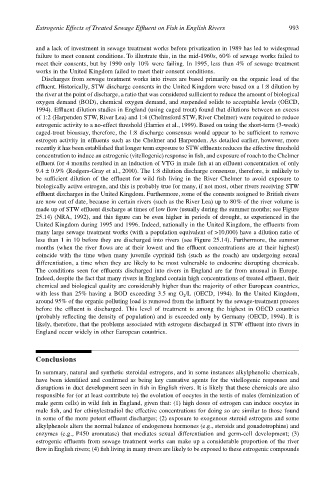Page 1013 - The Toxicology of Fishes
P. 1013
Estrogenic Effects of Treated Sewage Effluent on Fish in English Rivers 993
and a lack of investment in sewage treatment works before privatization in 1989 has led to widespread
failure to meet consent conditions. To illustrate this, in the mid-1960s, 60% of sewage works failed to
meet their consents, but by 1990 only 10% were failing. In 1995, less than 4% of sewage treatment
works in the United Kingdom failed to meet their consent conditions.
Discharges from sewage treatment works into rivers are based primarily on the organic load of the
effluent. Historically, STW discharge consents in the United Kingdom were based on a 1:8 dilution by
the river at the point of discharge, a ratio that was considered sufficient to reduce the amount of biological
oxygen demand (BOD), chemical oxygen demand, and suspended solids to acceptable levels (OECD,
1994). Effluent dilution studies in England (using caged trout) found that dilutions between an excess
of 1:2 (Harpenden STW, River Lea) and 1:4 (Chelmsford STW, River Chelmer) were required to reduce
estrogenic activity to a no-effect threshold (Harries et al., 1999). Based on using the short-term (3-week)
caged-trout bioassay, therefore, the 1:8 discharge consensus would appear to be sufficient to remove
estrogen activity in effluents such as the Chelmer and Harpenden. As detailed earlier, however, more
recently it has been established that longer term exposure to STW effluents reduces the effective threshold
concentration to induce an estrogenic (vitellogenic) response in fish, and exposure of roach to the Chelmer
effluent for 4 months resulted in an induction of VTG in male fish at an effluent concentration of only
9.4 ± 0.9% (Rodgers-Gray et al., 2000). The 1:8 dilution discharge consensus, therefore, is unlikely to
be sufficient dilution of the effluent for wild fish living in the River Chelmer to avoid exposure to
biologically active estrogen, and this is probably true for many, if not most, other rivers receiving STW
effluent discharges in the United Kingdom. Furthermore, some of the consents assigned to British rivers
are now out of date, because in certain rivers (such as the River Lea) up to 80% of the river volume is
made up of STW effluent discharge at times of low flow (usually during the summer months; see Figure
25.14) (NRA, 1992), and this figure can be even higher in periods of drought, as experienced in the
United Kingdom during 1995 and 1996. Indeed, nationally in the United Kingdom, the effluents from
many large sewage treatment works (with a population equivalent of >10,000) have a dilution ratio of
less than 1 in 10 before they are discharged into rivers (see Figure 25.14). Furthermore, the summer
months (when the river flows are at their lowest and the effluent concentrations are at their highest)
coincide with the time when many juvenile cyprinid fish (such as the roach) are undergoing sexual
differentiation, a time when they are likely to be most vulnerable to endocrine disrupting chemicals.
The conditions seen for effluents discharged into rivers in England are far from unusual in Europe.
Indeed, despite the fact that many rivers in England contain high concentrations of treated effluent, their
chemical and biological quality are considerably higher than the majority of other European countries,
with less than 25% having a BOD exceeding 3.5 mg O /L (OECD, 1994). In the United Kingdom,
2
around 95% of the organic polluting load is removed from the influent by the sewage-treatment process
before the effluent is discharged. This level of treatment is among the highest in OECD countries
(probably reflecting the density of population) and is exceeded only by Germany (OECD, 1994). It is
likely, therefore, that the problems associated with estrogens discharged in STW effluent into rivers in
England occur widely in other European countries.
Conclusions
In summary, natural and synthetic steroidal estrogens, and in some instances alkylphenolic chemicals,
have been identified and confirmed as being key causative agents for the vitellogenic responses and
disruptions in duct development seen in fish in English rivers. It is likely that these chemicals are also
responsible for (or at least contribute to) the evolution of oocytes in the testis of males (feminization of
male germ cells) in wild fish in England, given that: (1) high doses of estrogen can induce oocytes in
male fish, and for ethinylestradiol the effective concentrations for doing so are similar to those found
in some of the more potent effluent discharges; (2) exposure to exogenous steroid estrogens and some
alkylphenols alters the normal balance of endogenous hormones (e.g., steroids and gonadotrophins) and
enzymes (e.g., P450 aromatase) that mediates sexual differentiation and germ-cell development; (3)
estrogenic effluents from sewage treatment works can make up a considerable proportion of the river
flow in English rivers; (4) fish living in many rivers are likely to be exposed to these estrogenic compounds

